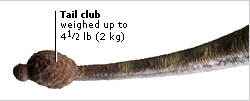DK Science: Defence
The dinosaur world was not over-run by gangs of vicious killers. Most dinosaurs were peaceful creatures that never attacked anything. Even so, each group had different ways of protecting itself against attack. For speedy dinosaurs, being able to out-run a predator was their main means of self-defence. Large sauropods may have used their great bulk to intimidate their enemies. Some dinosaurs carried weapons to defend themselves, striking back with their tails, horns, or claws. Other dinosaurs were more passive and relied on camouflage or body armour for their protection.
Not all dinosaurs were huge and lumbering. Some were built for speed, which they used to beat a hasty retreat from attackers. Gallimimus had the physical features of a sprinter. With its long, thin back legs, Gallimimus could take large strides efficiently, and its light body was perfectly balanced by a slender tail. By measuring their legs and comparing their shape to those of modern animals, experts have estimated that Gallimimus reached speeds of 56 kph (35 mph). This is almost as fast as a racehorse, and certainly speedy enough to evade capture by a larger predator, such as Tyrannosaurus.
Well-preserved fossils of dinosaur skin are rare and do not show the colour of the skin. We know that patterns and colour help modern reptiles to hide from their enemies, so it seems certain dinosaurs would also have used colour to blend in with their surroundings.
No living reptiles have defensive tails with attachments as spectacular as the clubs used by the ankylosaurs. The huge club at the end of Euoplocephalus’s tail was made out of several chunks of bone, all fused together into a single lump. Powerful tail muscles were used to swing the tail from side to side, delivering a bone-shattering blow to an attacker.
Heavy and lumbering sauropods, such as Diplodocus, could inflict stinging blows on attackers with their tapered, whip-like tails. Apart from their daunting size, this was their main form of defence. The ends of their tails were made up of narrow, cyclinder-shaped bones which were designed to lash out sharply. The mere sound of the tail cracking may have scared away a predator.
With their protective studs, plates, and spikes, armoured dinosaurs were like walking fortresses. When under attack, they may have crouched down to protect their soft bellies, presenting a completely armoured shell. The armoured dinosaurs evolved from small, lightweight species with just a few rows of studs on their back into huge beasts with full suits of armour.
To order this book direct from the publisher, visit DK's website.



